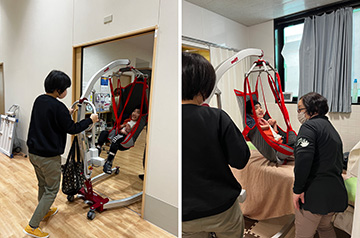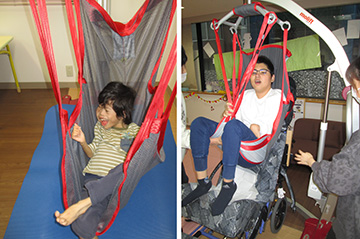2025.04.28
Events
A Case Study of Molift Subscription Services after One Year of Installation

Reported by New Business Development and Promotion Division, Pacific Supply Co. Ltd.
The social welfare corporation Jinenjyo began our subscription service of Molift care lift in December 2023. Initially, one lift was shared between two offices. In order to use it more efficiently, they subscribed to a second lift eight months later and have since been making great use of the lift at their facilities. We interviewed them about the changes over the past years since introducing the Molift lift, the background of its introduction, how it is currently being used,, and the impact and satisfaction it has brought to both users and staff.
Facility Introduction

Management Corporation
The social welfare corporation Jinenjyo
(Shimonoseki City, Yamaguchi Prefecture)
Daichi
Adult Day Care Service Center for People with Disabilities

User age: 18-48 years old (average 30 years old)
User weight: Mostly 30-40 kg, a few over 50 kg
Number of daily users: Approx. 15
Staff allocation: 1 staff member for 1.5 users
Muku
After-School Day Care Service Center for Children with Disabilities

User attributes: 5 people, ranging from elementary to high school students.
User weight: Several weigh over 40kg.Usage times: Available after school from 3 pm to 5 pm. During long holidays, from 9 am to 3 pm.
Staff allocation: Nearly 1:1
Could you tell us about how lifts were used at your facilities before introducing the Molift care lift in December 2023 through our subscription service?
When our facility was first established in 2004, ceiling hoists were installed. However, at that time, the number of patients was small and the staff was relatively young, so most of the caregiving works was performed manually. Although ceiling hoists were used only for specific routes such as toilets and bathrooms, they were not used very often, and manual caregiving was the norm.
However, as the years passed, the number of patients of our facilities increased and the age range of the staff became wider. In addition, as patients continued to attend our facilities over a long period, their physical conditions changed and also there are some patient turnover, leading to a wider variety of physical characteristics and needs among individuals. In light of these changes, we began to consider using equipment for transfers—for the benefit of both patients and staff.
In 2021, when we had the opportunity to build a new facility, we held study sessions on no-lift care. As a result, the importance of this approach gradually began to be recognized within the facility. This led to growing discussions about introducing assistive devices and lifts to improve the efficiency and safety of caregiving tasks.
However, the introduction of a care lift like Molift fell through at the time because many staff members felt uneasy about handling the mechanical equipment, and there were also several operational challenges related to its installation. In some cases, the devices we tired at the time were not well-suited to the individualized care approaches based on each person's physical condition and needs. Additionally, there was psychological resistance from both users and their families toward using lifts for transfers. As a result, our facilities were unable to move forward with the introduction of lifts and instead opted to install electric height-adjustable beds.
In our facility, unlike in residential care settings where each person has a designated bed they stay in, our patients spend time in different ways throughout a shared space — sometimes lying down, sometimes propelling themselves in wheelchairs, or walking around on their own. Because of this, we faced challenges in figuring out how to move and use the lift appropriately according to each situation. Even now, we continue to think carefully about how best to operate the lift in such a flexible environment.
Given those challenges, what made you decide to try Molift?
In 2023, a turning point came when we had the opportunity to trial a demo unit of a care lift "Molift" for one month. This lift could be smoothly integrated into our existing care practices without significantly altering the way our facility operated. During the trial period, staff members experimented with different slings tailored to each individual user, searching for the most suitable combinations and sharing their successful experiences with one another. What was especially valuable was the chance to try out slings appropriate for users with physical deformities, which gave us a real sense of confidence about the lift’s practical use in our facility.

During the demo period, both patients and staff members were given ample opportunities to actively try using the lift, and staff members experienced firsthand the convenience it offered in providing care. For example, when assisting patients weighing over 60 kilograms, only a limited number of staff members had the physical strength and skills necessary to provide support. When care becomes overly dependent on specific individuals, it can create a sense of frustration or guilt among staff members—between those who can provide support and those who cannot. From the patients' perspective, not having a caregiver available who can assist them may also lead to feelings of anxiety. Introducing a lift that anyone can use, without these emotional or physical barriers, gave us a strong sense that we need to build a care environment where patients feel safe and staff members can work with greater confidence and stability. By introducing a lift that can be used by anyone, without everyone having such feelings, it led us to think that we must promote facility management in which patients can feel at ease and staff members can be retained.
Another key factor in our decision was the subscription-based model, which allowed us to move forward without the burden of a large initial investment or the pressure of a long-term commitment, as would be the case with a full purchase. Given the constantly changing conditions of our patients and the evolving nature of care, the flexibility offered by the subscription model was a major advantage for our facility’s operations. Following the trial period, the care lift "Molift' proved to be a valuable tool not only for the staff members but also for the patients, ultimately leading to the decision to implement it officially.
Being able to use the care lift "Molift" on a subscription-based model was a big advantage. So what specific effects did you notice after using it?
Since the introduction of the Molift, the way transfers are carried out in our facility has begun to change. For patients, transfers have become smoother, and some have even experienced psychological benefits—such as enjoying the shift in perspective while being transferred. At our after-school day care service center, some children happily shout “Yoo-hoo!” while being transferred on the lift, and others enjoy playfully tapping their feet on the floor or spinning around while carried in the sling.

Meanwhile, for staff members, not only has the physical burden such as back pain been reduced, but the use of the lift has also created more leeway during transfers, allowing for increased communication with the users. With our previous manual assistance, staff members were often too focused on carrying to notice the patients' expressions. Now, by using the lift, we can observe their facial expressions and offer reassuring words, helping patients feel more at ease.
Across the entire operation, we are working to ensure that assistance is not dependent on individual staff members, creating a system where any staff member can support patients, even those with larger body types. This has helped reduce the imbalance of physical burden among staff members and has created a greater sense of security for both patients and staff members. We hope to prevent situations where staff members, who have built strong relationships with patients, are forced to resign due to issues like back pain that prevent them from continuing care.
It seems that the care lift "Molift" has become an indispensable part of daily care in your facilities. Do you have any future expectations or requests for subscription services?
Based on our experience with the introduction of the Molift, we would appreciate even greater flexibility moving forward. For example, if there were more options for lifts included in the subscription service that could be adapted to future changes in patients’ or staff’s needs, we believe the lift could be utilized in an even wider range of situations. Additionally, we are also interested in contributing to the promotion of no-lift care by increasing opportunities for facility tours and sharing case studies.
By having the family members of patients see how transfers are performed using a lift at the facility, we have been able to reduce the psychological barriers associated with using a lift. We've even received positive feedback such as, "It looks easier for both of us." In some cases, this has led to families deciding to introduce the lift at home as well.
Through these ongoing efforts, we hope to find sustainable ways of care at the facility that can be maintained comfortably by both users and staff—not just now, but five or even ten years into the future. We also hope that awareness of the Molift will become more widespread in society moving forward.
Lastly
It has been one year since the introduction of the Molift. We have learned from our conversations that the Molift has become “indispensable” and is contributing to the creation of an environment where staff members, patients, and their families can spend their daily lives with peace of mind, not only now, but also in the future. We will continue to strive to ensure that the use of our products and subscription services leads to results in terms of ease of work for the staff and improvement in the quality of facilities' operations.
If you are interested in the Molift or considering its introduction, please feel free to give it a try.
For further information or inquiries, please contact us via this link.

